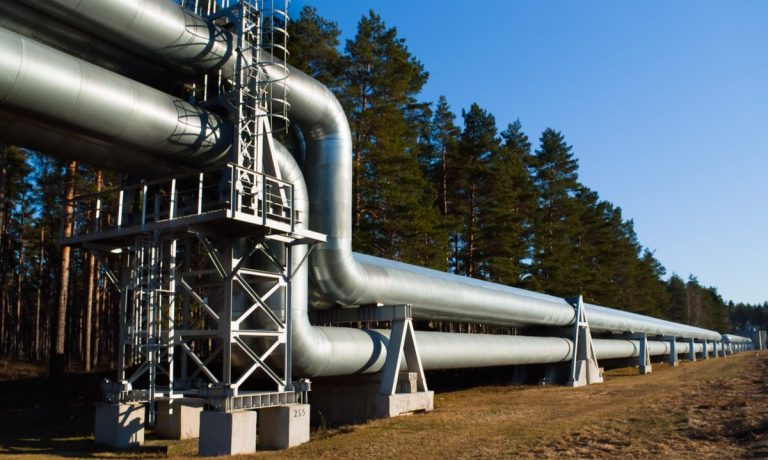
Across Europe, the continent’s overreliance on Russian gas has been a hot topic ever since relations with the country soured following its invasion of Ukraine earlier this year.
Earlier this month, G7 leaders agreed to impose a price cap on Russian oil in an attempt to stem the flow of funds into the Kremlin’s war coffers.
In the immediate aftermath of the decision, Nord Stream 1, the world’s longest operational natural gas pipeline that runs under the Baltic Sea from Russia to Germany, was conveniently shuttered by Russian state-owned oil and gas firm Gazprom, citing a detected leak.
A few days later, the Russian fossil fuel behemoth had stated that supplies running through the pipeline, which can deliver up to 55 billion cubic meters of gas per year, would be halted indefinitely.
With winter just around the corner, this can only spell bad news for Europeans already facing the highest energy prices on record.
Then U.K. Prime Minister, Boris Johnson, anticipated the challenge in a recent speech as he made a direct link between Russia’s actions and Europe’s current cost of living crisis: “We know the coming winter will be tough and Putin will manipulate Russian energy supplies to try to torment households across Europe.”
More on this: UK’s 10% Inflation Rates Stretch Consumers’ Paychecks and Patience
But it seems Portugal can help provide some relief.
Commenting on a potential pipeline connecting the Iberian Peninsula to central Europe, the country’s Prime Minister, Antonio Costa, said in August that “Portugal can play an important role” in helping to make Europe “energy self-sufficient” regarding Russia, explaining that Portugal and Spain could send a lot of the liquefied natural gas they receive from around the world to other E.U. countries.
The problem, however, is that cross-border infrastructure projects typically take years to complete, and it will likely take a while for any continent-wide project to see the light of day.
For example, between the idea initially gaining political momentum in 1997 and the official inauguration of the Nord Stream 1 pipeline in 2011, more than a decade had been spent negotiating, planning, and securing the nearly 15 billion euros needed to finance the initiative.
Against that backdrop, investors will likely be taking note of the giant question mark currently hanging over another Russo-European pipeline, Nord Stream 2. That project, although theoretically ready to start pumping, has been mothballed ever since Germany pulled its support two days before the first Russian troops landed in Ukraine.
Despite recent calls by Wolfgang Kubicki, the vice President of Germany’s parliament, to open Nord Stream 2 in order to prevent an European energy crisis, the needle has barely moved. In fact, as things stand now, the pipeline looks like one giant expensive tombstone commemorating the death of post-soviet collaboration between Russia and the EU.
Financing Europe’s Green Energy
Compared to the multi-billion-dollar budgets needed to pump gas from one side of the continent to the other, renewable energy sources offer an attractive alternative to Europe’s deepening energy crisis.
Both wind and solar electricity can be generated at a far more affordable and accessible scale, which can range from a few solar panels that plug directly into home circuits, to giant offshore wind farms capable of powering entire cities.
The way renewable energy initiatives are financed has also taken a different route to their fossil fuel equivalents. Whereas big-budget gas projects require the highest level of political orchestration, the landscape of renewable energy in Europe is characterized as much by grassroots funding as it is by top-down government involvement.
Read more: Ostrom Raises $5M to Go Green
For instance, several crowdfunding platforms have emerged that cater to the needs of Europeans looking to pay for their own clean energy. These platforms create novel financing mechanisms for sustainable investment and provide stakeholders with access to clean electricity, severing their dependence on legacy, fossil fuel-burning energy companies.
Related: Crowdfunding Sites Finance Ukrainian Journalism
One of such is Dutch company Windcentrale which has created an innovative energy solution that allows people to become shareholders in wind turbines.
Through a collaboration with the energy company Greenchoice, Windcentrale uses the electricity generated by its turbines to fuel homeowners’ energy contracts. After an initial investment, shareholders pay as little as 15% of the going electricity price for the duration of the turbine’s operating life.
While Windcentrale offers a non-traditional investment product that allows participants to reap dividends in the form of electricity, other European platforms such as Abundance Investment are pursuing a crowdfunding model that delivers real monetary returns from renewable energy projects.
The British company helps finance green initiatives from building renewable infrastructure to funding sustainable technology companies, while assisting both private companies and municipal councils crowdfund their green initiatives.
Related: HSBC Egypt Offers Financing Options for Green Purchases
This means that councils gain an additional source of capital to finance investment in things like upgrading their housing stock and buying electric vehicles. And it also gives ordinary people exposure to a low-risk investment class otherwise reserved for institutional lenders.
For all PYMNTS EMEA coverage, subscribe to the daily EMEA Newsletter.